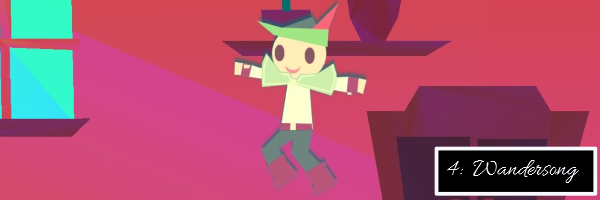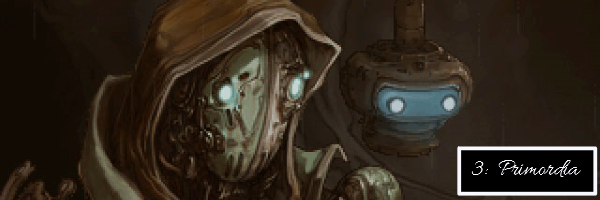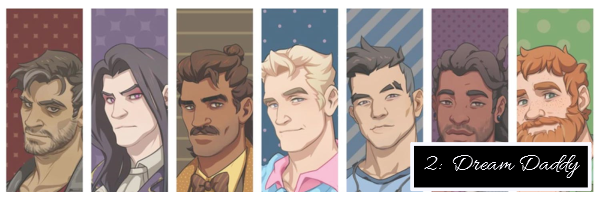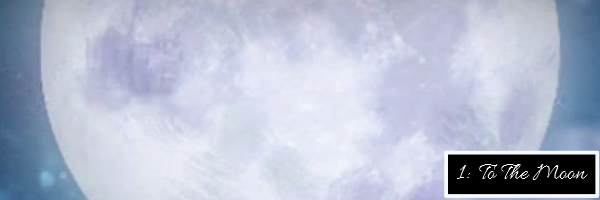DISCLAIMER! This is a SUBJECTIVE, PERSONAL list.
Very often, when I think about gaming, I think about the heyday of the genre – for me, anyway. That stretch right between 1986 and 1998 where the adventure game was on the rise and where “technical wizardry” amounted to somehow jamming a movie into your game.
It was a time of experimentation. A time of learning. As much for the developers as for the players, who slowly came to demand a much more interesting game than what the arcades had been offering just a few, scant years before that.
We didn’t just want high scores anymore. Or a life counter. We wanted stories that would move us and that would reflect the growing-up of our nascent hobby. The problem – then – was that the technology wasn’t really quite on par with the stories that people were trying to tell.
Oh. There were a few standout hits. Grim Fandango and The Dig, both made by Lucasarts, told amazing, heartfelt stories. Ultima 4 showed that you didn’t need an antagonist to make a thought provoking game and The Perils of Rosella – the fourth King’s Quest outing by designer Roberta Williams showed that you could have a lead that wasn’t just a strapping, young lad.
But that drive – that slow push toward innovation – slowly gave way to formulas. A rigid, set-in-stone philosophy about how to design games that would take almost a decade and a half to undo.
And how did it get undone? It came undone under the weight of the new mad scientists. And very often, those mad scientists didn’t believe in meddling in the mainstream. They wanted to make games on their terms and with these new technologies. But they didn’t want to get strapped to the ticking time bomb that was the AAA games industry.
And that, friends, is where I come in.
I grew disenchanted with the AAA industry the more it settled into rigidity. I didn’t like that everything turned into a formulaic brown shooter. Or a me-too MOBA. Or – in our current hell scape, a monetized, lootboxized nadir of Battle Royale tedium.
But those indies? They drew me in. And I have been happy to appreciate the new fruits of these labours.
So, without further ado, I’d like to talk a little about my games of the decade. All mostly underdogs. And all made with a great deal of heart and a great sense of pride in the medium. These games – for me – saved gaming as a hobby. And I’m grateful they’re with us and I look forward to what the next decade holds for indie games development as a whole.
10: Order of the Thorne: The King’s Challenge
Of all the games on this list, this is one of the few that’s a direct throwback to days of yore. Infamous Quests set out to make a game that borrowed, heavily, from the very earliest King’s Quest games. There’s no existential threat here [until the very, very end of the game] – everything is colourful. The places you go to and the people you meet are all very animated and have their own personalities. But rather than settle for the old school design of moon logic for puzzle solutions, Infamous Quests dole out puzzles that absolutely make sense and that have solutions you can see from the inventory items you own and the world around you.
The important thing for me is that we don’t see enough of this very straight-ahead sort of game design anymore at all. There’s a gentle and easy simplicity to Order of the Thorne that traces it’s lineage all the way back to 1984. Go places. Collect items. Combine them to solve puzzles. Engage in the quest. It’s wonderful and heartfelt and a gentle reminder of a time-long gone.
Thank you, Infamous Quests so, so much for a beautiful little game that reminded me of why I even got into the hobby in the first place.
9: Thomas Was Alone
If Order of the Thorne was a look backward, then Thomas Was Alone is very much looking forward. Yes, it’s design is very minimal. And sure, all it basically amounts to is a puzzle platformer, but it does something that a book could never do, and a movie could only ape, badly: it tells a very video game story. And it does so in a way that only a video game possibly could.
Thomas is the story of a sentient block that has a distinct property. He can jump. But only so high and only so far. He has to use his jump to solve an obstacle course that starts off pretty simple and slowly ramps up in difficulty until you’re scratching your head and wondering how you’re going to get him from point A to point B.
But the OTHER thing is what’s most important about Thomas. This particular game imbues it’s rectangle with substance – by which I mean that Thomas has a personality and a tone that – by the game’s end – makes you connect with this simple, little line in a way that’s somehow lacking from most in-game protagonists.
Thomas took the idea of Ultima 4 – that you don’t need a big bad – and RAN with it, all the way to the finish line.
I feel a little more strongly for it’s expansion [Benjamin’s Flight] which – by it’s very end – moved me to tears – over mere rectangles. And this, then, is why I feel Thomas is so important. It has proved that early sentiment correct: you can do a lot with a little, if you’re careful.
8: Gone Home
New stories in new ways for a new audience.
That’s some of the narrative for this decade. And Gone Home was a bit of a springboard for this new manifesto for gamers who were a little on the wayside. Oh. There’d been amazing games of this stripe before Gone Home – the wonderful Journey is the poster child for this style of experience, but I never played that, so we’re talking about the one I did actually work my way thorugh.
Gone Home starts off simply enough: you arrive home and no one’s around. It’s all wet and miserable, so you step inside and start rummaging through the house, trying to figure out where everyone’s at. And as you dig through little family mementos and knick-knacks, you begin to see your family in a whole new light.
There’s lots of very subtle stuff happening in little layers with you, your Mom, your Dad and your sister. And this, then, is what drives Gone Home forward. There’s some misses in the tone department: your initial impression is that it’s going to be a horror game with horror tropes, but every time you come across something that looks like it’s going to tie into that horror narrative, it ends up being a near-miss, but – on the whole – Gone Home admirably introduced the idea of the Walking Simulator to our modern, gaming lexicon and I am grateful that it allowed new gamers a chance to get their feet wet with the hobby in a way that didn’t stress fighting as a game mechanic.
7: Evoland 2: A Slight Case of Spacetime Continuum Disorder
I really loved Evoland 1. It was a clever little idea wrapped in – what I felt – was sort of a demo toy. In that game, you travelled through eras of gaming – all the way from the time of the venerable Gameboy through to the sixteen bit Playstation era.
As you did, the game changed around you. At first, these changes are just graphical. The sprites give way to early 3D models. The 3D models gained better textures. The backdrops became beautiful CG renders. But underneath all this, the game slowly evolved, too, moving from an early Zelda style to a full-on JRPG turn-based package with spells, command menus and battle animations.
The trouble was, it was short. And while it committed to it’s idea, it didn’t commit for long enough to explore the nooks and crannies of that style. Enter Evoland 2. There’s still some jankiness involved in being inside a particular era of gaming [some styles are simply little minigames that don’t do their base idea much justice at all], and the story unfolds in that same, slightly farcical way that the original did, but the difference is night and day. Evoland 2 is a GAME. Not just a ramshackle little demo.
It’s a great game that shines a light on older ideas and explores our shared history in a way that few modern games are interested in. So, it’s a history lesson. But for me, it was a little more than that.
I’d grown incredibly wary of big games that wanted 40 to 60 hours of my life. Evoland 2 pointed the way toward a sort of game that didn’t have to JUST be “do this one thing for 60 hours.” And for this, I have to thank it. I’ve since completed some older games that demanded my time [the wonderful Titan Quest, for example] and I owe it to Evoland 2 for restoring my faith in the “massive RPG” that I’d given up.
6: The Book of Unwritten Tales
If Order of the Thorne was mostly about treating the past with a certain sort of reverence, then The Book of Unwritten Tales was all about seeing the past, thinking of it through a Space Quest lens and then deciding that was the way forward.
The MMO genre gets a joke! And fantasy tropes get a joke! And card games get a joke! Everyone gets a joke!
But the thing is: Book of Unwritten Tales is an absolutely solid adventure with solid puzzles that are absolutely logical. Almost nothing here seems or feels unfair. And even if you can’t immediately work out what to do, the game drops hints and is all-too-happy to nudge you in the correct direction.
In short, it’s the old adventure game formula, but dusted off and modernized, even when it’s poking fun at ye classicks of olde. Yeah, it’s animation is a little stiff, and certainly it’s characters aren’t the best looking in the business, but they all have a certain charm to them that AAA gaming seems to lack.
In the beginning of a decade where people were absolutely sure the adventure game genre was dead, the Book of Unwritten Tales came along and pointed a gentle finger forward. “You can have your classic games,” it seemed to say, “just know that you have to share the genre with a younger crowd. This is how we get them on board.”
5: Shovel Knight: Treasure Trove
I’m not good at twitch-based games. Ever since my formative gaming years, playing Asteroids, Space Invaders and Galaxian, [and all those other coin-operated games that were so instrumental in launching the industry] one constant always remained true: my hand-eye co-ordination was never my strong suit.
So I dabbled in what turned out to be formative and classic experiences for most gamers in the 80’s, but never really rode that wave: Mario? Skipped that. Zelda? Skipped that. Paper Boy, Xevious and R-Type? I tried. Double Dragon, Altered Beast and Contra? The only way I could play those was if someone competent was playing along with me.
I had functionally given up on games that required great reflexes, because I always felt let down by my own response times. That is, until the genre opened up to me in this decade. And my first love, and the key to those genres, was Shovel Knight.
Shovel Knight borrows A LOT from the past, but it also looks to the future. You can make the game difficult for yourself, but you don’t have to. You don’t have lives, just an ever dwindling stash of cash. The original is all about solid, weighty platforming. For the most part, when you tell Shovel Knight to jump, he jumps. Want to pogo? You can do that, and the response time is instant. Everything about the original game is precise. Well thought out. Engaging.
You may notice that I’m skipping on the DLC, well, there’s a reason for that. ALL of it took that slow, methodical carefulness the game was so good at and threw it away for other gimmicks. This is a design direction I don’t quite understand, but I’m grateful that Yacht Club made the game they wanted to make. And I’m SO grateful that it caught on. I am also glad to have played it.
It gave me the courage to try Banjo Kazooie, and Spyro and a host of other games I would have otherwise ignored as “too difficult for me.”
4: Wandersong
After Shovel Knight, I was willing to try other platformers.
And easily one of the best I’ve played since then is Wandersong. Not so much for it’s actual platforming, but more for it’s inherent positivity. In a gaming landscape that’s mostly all about gritty action heroes and grimdark settings, Wandersong’s bard is a breath of fresh air.
Wandersong oozes gentle, good feelings almost no matter how dire the situation gets in-game. Even when the bard is at his lowest, he can still sing. [Even if, then, his voice is tremulous and soft.]
This is the sort of game we need more of. It perfectly embodies that there’s still hope, even when things seem the most hopeless.
Plus, it’s vibrant and beautiful and full of song. And more games certainly need to borrow – if not it’s colour palette, then it’s sensibilities with regards to being less brown and grimdark.
3: Primordia
I know, I know. I’ve just been railing against grimdarkness. And here we go talking about THE MOST MUDDY AND BROWN LOOKING GAME IN EXISTENCE. But wait! Hear me out!
Ever since games like Planetfall, developers have been trying to get gaming companions right. We’ve had Navi. We’ve had Cedric. We’ve even had Peter Dinklage [!] - the problem often is that those companions aren’t great. Enter Crispin.
In the world of Primordia, man has been ousted from the Earth. And the Earth, in turn, has become overrun with robots. Robots of all sizes and shapes. Some are as big as an entire city, while others are tiny, tiny little things. Our protagonist for this game is Horatio. And Horatio has built himself an assistant/buddy in Crispin. And Crispin is GREAT.
He will talk back to Horatio. He will suggest lines of enquiry. He will [minor spoilers] fall in love with another robot. And all because the folks over at Wormwood realized that in order for a companion to be great, they had to be lifelike.
But this doesn’t even get into how great a game Primordia really is. If this list had been drawn up for the 90’s, I would have stuck Inherit the Earth somewhere in this list. Primordia really feels like that game from a completely different angle.
Primordia feels like what ITE might have been like if ITE had been allowed to release as intended. [Publisher meddling knocked ITE into a kid-friendly narrative that betrayed it’s somewhat more serious, original tone]
And Primordia is wonderful. Like The Dig before it, it chooses to explore heavy, heavy subject matter, but in a way that’s always a little playful. It recognizes that there’s a line here, and that drawing it is very important.
And that, for me, is part of why Primordia scores so highly. It has good writing, fantastic pacing and a payoff that’ll leave you emotional. And that, I think, is the mark of a good game.
You get a great time wrapped in excellent writing with an ending that is thought provoking and meaningful.
2: Dream Daddy: A Dad Dating Simulator
Dream Daddy has faults. The folks making it wanted to stomp some of their own morality into the game, so they added a path where you can’t win [for moral reasons] one of the Dads into the game.
There’s DLC that then undoes all that careful morality by dumping a cult sub-plot into the game.
It has...weird priorities in that regard.
But when it’s NOT doing any of those things, Dream Daddy is beautiful, gentle, sublime art. It ditches the man-versus-world narrative for man-with-man stories that are small-scale and heartfelt.
Everything about it is a little labour of love. Everywhere you look, there’s a Dad joke. Amanda, your daughter, is a wonderful young lady who’s learning about herself all the way through the story. You can play as [almost] any kind of Dad you want to inhabit. Want to be an overweight, bearded guy? The game lets you. Want to be a Goku-alike? You can do that. There’s even great inclusive options for transgender folk.
In short, Dream Daddy wants you to feel at home. It wants you to soak up it’s earnest, homebody charm. It wants you to see that people are complex in their own small ways. And in all these respects, it is a triumph of video game writing.
Each Dad has their own arc and each arc presents a Dad that you come to know in small ways – ways that are often neglected by most games in favour of tropes. Hugo loves books and bookishness, but he’s also not sure how to cope with his son Ernest, who’s At That Age. By contrast, Brian and his daughter have great rapport and he loves the outdoors [and fishing, in particular.]
This makes each Dad unique and not just some kind of tone to wrap the story around.
And that’s something that other video game writers could stand to learn. For all their faults, Telltale – when on form – understood that the characters in a game had to be human [or mostly so] in order for you to relate. Dream Daddy understands that, too. In spades.
1: To The Moon
I’d been curious about To The Moon since it came out. Taking the beautiful music of Laura Shigihara and sticking it into a game that seemed like it was about “time travel” sounded great, to me, on paper.
In practise, lots of people didn’t find that there was “much game” to To The Moon, and mostly, there isn’t. There is one awful “gamey” segment near the end that undoes a lot of the game’s very careful build. But that’s not really why I played To The Moon.
I played To The Moon because it told a heartfelt, genuine story of great love between two people.
Johnny Wyles loves River, his wife who has recently passed away. In the game, he’s right on the verge of death, himself. But Johnny has a final wish: he wants to go to the moon. Enter Neil Watts and Eva Rosalene. Both work for Sigmund Corporation. And they can help you with a final wish like that.
In Johnny’s case, this means trekking back through his memories so that you can figure out WHY he wants to go to the moon, and what you uncover as you do that is heartbreak in three hours. But a gentle, beautiful sort of heartbreak that we so rarely see in games.
And this, for me, is why To The Moon is arguably the most important game of the decade. Yes, it’s very lo-fi in the graphics department, but it’s writing and it’s music and the way it’s all tied together are a great revelation. It is as if though in this one game, we’ve finally caught up to realizing how important the art of careful writing can be.
Think about books that have moved you. Or movies that have made you think. Or music albums that have stuck with you. Most of those are well-crafted in ways that touch you as a person. To The Moon makes me hope, with all my heart, that one day, I will love someone half as much as Johnny and River loved each other. That I will be absolutely devoted to my dream in the way Johnny was to his. That I will eventually make something that reaches people in the same way that To The Moon spoke to my heart and mind.
To The Moon made me cry.
It was another reminder of why I’d gotten into gaming all those years ago. I’d thought – back then – that games could be the mindful literature of our time.
EA – before they became the Antichrist of the gaming world – published a very particular ad that has stuck with me for all these years: they asked the pertinent question, “Can A Computer Make You Cry?”
The answer is yes. Yes, it can.
Thank you Freebird Games for reminding me that games can be greater than just the latest graphics technology.
And that’s it!
I’ll see you again in ten years when we talk about the games of the 2020’s.
Happy New Year!
And be kind to one another.
Some images courtesy of Pixabay: https://www.pixabay.com

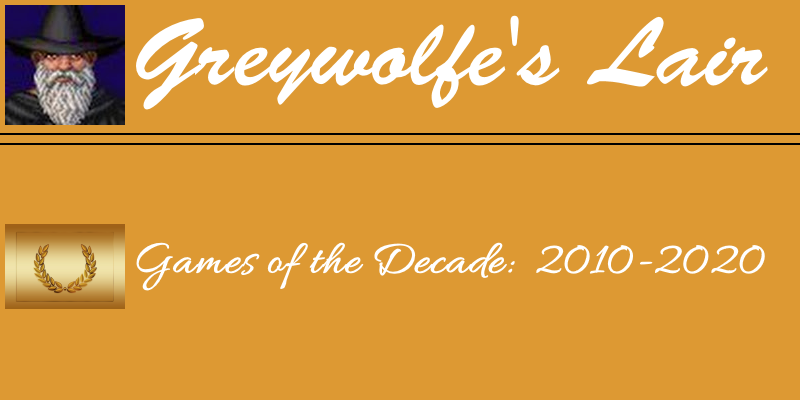
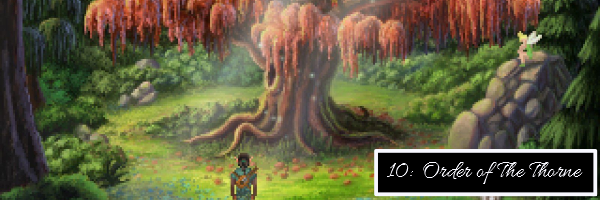
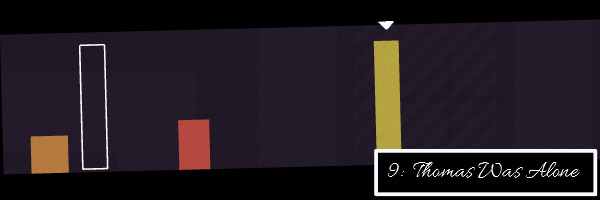
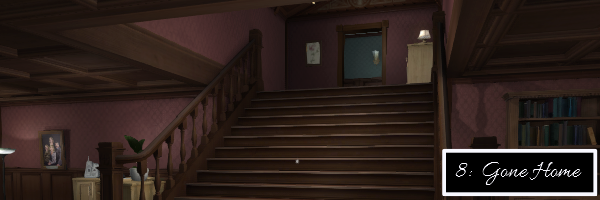
![An image showing three "time spots" in Evoland [a game about time and manipulating time.] - on the far left, time is indicated as "the far past" by old-style pixel graphics. The middle section showcases "the near past" as nicer pixel graphics. The final time related graphic is just of "the past" with nice, stylized early 3d graphics. There is also an indicator that suggests we're at number 7 on the list and a text box that tells us that this is "Evoland 2"](http://twinstiq.com/wp-content/uploads/2020/01/7_evoland_text.png)
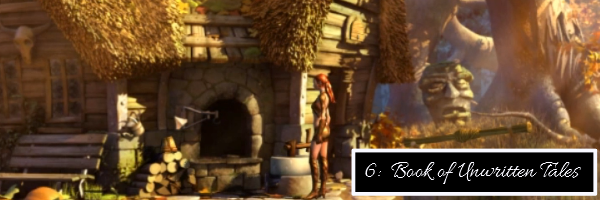
![This image shows the starting screen of Shovel Knight, with the titular knight holding his weapon [a spade] in the air, raring for adventure. There are trees all around and an ominous castle in the background. There is also text to signify that this 5th game on this list is, in fact, "Shovel Knight."](http://twinstiq.com/wp-content/uploads/2020/01/5_shovel_knight_text.png)
